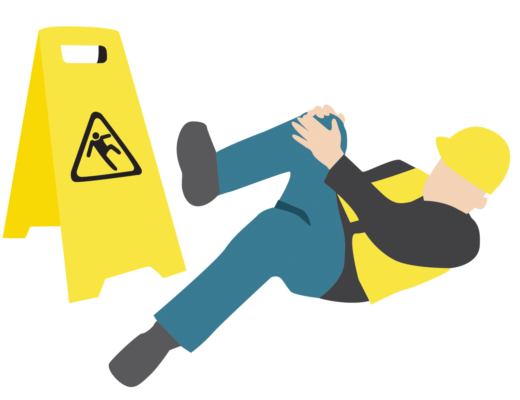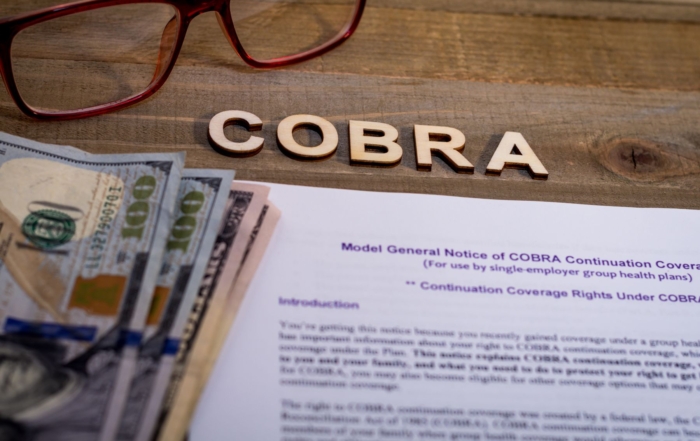Falls are the second leading cause of unintentional death in the United States and the most common cause of traumatic brain injuries (CDC). While not all falls are fatal, and many don’t cause any harm, one in five falls results in severe injuries such as broken bones or head trauma. In 2020, 805 people died at work due to a fall, and 211,640 received injuries bad enough to require days away from work (NSC). Employers that are serious about protecting their workers and their company must take proactive steps to prevent slip, trip, and fall accidents in the workplace.
The mechanics of slip, trip, and fall accidents
There are three things involved in slips, trips, and falls—friction, momentum, and gravity. Your center of gravity is the point where the weight of your body is evenly distributed. Imagine yourself standing up straight with your feet shoulder width apart. Now imagine three points, one on each foot and one on your lower back, forming a triangle. If the point on your lower back—your center of gravity—extends past either of the lower two points, you can lose your balance and fall.
The shape and size of your body determines your center of gravity. Shorter people have an easier time maintaining their balance due to a lower center of gravity. In contrast, taller people are less stable, and it takes less force to move their center of gravity past their feet. When you walk, your center of gravity shifts, and for a brief moment, you become off-balance. If you are unlucky enough to encounter a slip or trip hazard at that moment, you are likely to fall.
A slip occurs when there isn’t enough friction between your feet and the walking surface, like slipping on a greasy floor or an icy sidewalk. A trip is when your foot or lower leg comes in contact with something unexpectedly and stops, or you step down to a lower level and your momentum continues to move your body forward.
We’ve all likely tripped on a door threshold or unexpectedly stepped off of a curb and lost our balance. Most people only lift their foot about half an inch off the ground with every step, which means anything half an inch or taller could potentially trip them. Things like uneven surfaces, tools, floor mats, or power cords can all cause a fall.
There are two types of falls—falls to the same level and falls to a lower level. You don’t have to fall far to be seriously injured; 136 of the 805-workplace slip, trip, and fall deaths in 2020, fell to the same level (NSC). According to a 2019 U.S. Bureau of Labor Statistics report, falls on the same level was the second leading workplace injury resulting in days away from work. You don’t have to slip or trip to have a fall either. Anytime your center of gravity extends past your feet, like overextending yourself while reaching for something while on a ladder, you could likely fall.
Who is most likely to be involved in a slip, trip, and fall accident
Construction workers are more than seven times as likely to be involved in a fall accident than other industries, and 37.9 percent of all fatalities within construction were from falls (BLS). While the construction industry is the most affected, no industry is immune to slip, trip, and fall accidents.
Age has been identified as one of the most significant contributors to falls, and that risk continues to increase with age. In fact, fall death rates amongst older adults in the United States increased by 30 percent between 2007 and 2016, according to the CDC. The trend is unsettling, and steps must be taken to protect these at risk employees. This trend is possibly due to the physical, cognitive, and sensory decline associated with the aging process.
Preventing slip, trip, and fall accidents in the workplace
Providing employees with safety training is one of the most effective ways to create a safer working environment. Train your employees to spot slip, trip, and fall hazards, like clutter, protruding objects, and wet conditions; never assume they already know.
Supplying the right PPE is the responsibility of every employer, but OSHA may not mandate some items. However, just because the government doesn’t force you to purchase a particular type of PPE doesn’t mean it is not a good business decision. Besides pain and suffering, accidents also cost a lot of money. If you have employees working in slippery environments, providing high-quality non-slip shoes or boots will likely pay for themselves in the long run.
Poor housekeeping is one of the leading causes of slip, trip, and fall accidents. Yet, the cleanliness and organization of a work area is a commonly neglected part of workplace safety. These types of hazards often go weeks or months without being fixed. Combat the issue by making housekeeping and hazard identification everyone’s responsibilities. The more you empower your employees to identify and fix hazards, the safer your workplace will become.
Finally, make sure you have a plan for handling accidents if they do occur. The goal of any accident investigation should be to determine why it happened and what steps to take to prevent it from happening again. Developing standard protocols will allow you to collect consistent data and ask the right questions making trends more noticeable and root causes easier to identify. Post-accident physical assessments can also help to prevent reoccurrence by identifying risk factors amongst your workers to mitigate future concerns.
While slip, trip, and fall injuries are common, they are also preventable. By implementing these tips, you will be on your way to creating a safer workplace.
Thanks to our friends at Occupational Health and Safety for content in this piece
Recent Posts
New Rules, Same Solution: NARFA Handles Compliance So You Don’t Have To
Everyone's talking about the insurance rate explosions, which seem to increase every year. But while you're focused on managing costs, Washington is preparing a wave [...]
Beyond Paperwork: How Your Benefits Administrator Becomes Your 2025 Benefits Strategy Partner
The 2025 Reality: Why Off-the-Shelf Plans Aren't Working Every year, the renewal notice arrives with a painful rate increase. For small and mid-sized businesses, this [...]
Due Diligence Checklist: How Strong Corporate Governance Increases Business Valuation
Whether you are raising capital, securing financing, or preparing for a sale, your company’s corporate structure and governance tell a story. That story can either [...]




